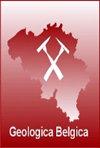比利时斯塔夫罗特-文恩地块下古生代地层“pouhons”的矿物学和水文地质研究
IF 0.7
4区 地球科学
Q2 GEOLOGY
引用次数: 2
摘要
许多天然富含二氧化碳的矿泉水泉,在当地被称为pouhons,出现在斯塔韦洛特-维恩地块。这些泉水显示出铁、锰和锂含量高的特殊成分,其特征是由于陆地表面附近的氢氧化铁沉淀而呈现出橘红色。氡测量表明,这些含铁沉积物具有弱放射性。La Gleize组的上寒武统黑色页岩也显示出放射性异常。富三价稀土(Pb、U、Y、Ce、Zr、Ti、Nb),贫过渡金属(Co、Ni、Cu、Zn)。发现了一些特殊的矿物,如萤光石(Ce)、独居石(Ce)、xenotime (Y)和锆石,它们可能是放射性异常的成因。铀逐渐从这些矿物中浸出,在溶液中运输,最后浓缩成含铁的泥。这些泥浆主要由针铁矿(通常是无定形的)、残余石英和方解石组成。最可能的假设是,铀以小浓度吸附在针铁矿表面。另一方面,Ottre形成(奥陶系)似乎是锂的主要来源,铁和锰。因此,Pouhon水在其地下循环过程中可能浸出了各种矿物学和化学成分的岩石。本文章由计算机程序翻译,如有差异,请以英文原文为准。
Mineralogical and hydrogeological study of "pouhons" in the lower Palaeozoic formations of the Stavelot-Venn Massif, Belgium
Numerous naturally CO2-rich mineral water springs, locally called pouhons, occur in the Stavelot-Venn Massif. These water springs show a particular composition with a high content of iron, manganese and lithium, and are characterised by a red-orange colour resulting from iron hydroxide precipitation near the land surface. Radon measurements have shown that these ferruginous deposits are weakly radioactive. The Upper Cambrian black shales of the La Gleize Formation are also known to display radioactive anomalies. These rocks show enrichment in HFSE (Pb, U, Y, Ce, Zr, Ti, Nb) and are depleted in transition metals (Co, Ni, Cu, Zn). Specific minerals such as florencite-(Ce), monazite-(Ce), xenotime-(Y) and zircon have been identified and are probably at the origin of the radioactive anomalies. Uranium was gradually leached from these minerals, transported in solution, and finally concentrated in ferruginous muds. These muds are mainly composed of goethite (most often amorphous), residual quartz and calcite in some samples. The most probable hypothesis is that uranium is adsorbed in small concentrations on the goethite surface. On the other hand, the Ottré Formation (Ordovician) appears to be the main source of lithium, iron and manganese. Pouhon waters have therefore probably leached rocks of various mineralogy and chemical composition during their sub-surface circulation.
求助全文
通过发布文献求助,成功后即可免费获取论文全文。
去求助
来源期刊

Geologica Belgica
地学-地质学
CiteScore
4.70
自引率
27.80%
发文量
8
审稿时长
>12 weeks
期刊介绍:
Geologica Belgica is a Belgian journal that welcomes papers concerning all aspects of the earth sciences, with a particular emphasis on the regional geology of Belgium, North West Europe and central Africa. Papers not dedicated to the geology of Belgium, North West Europe and central Africa are only accepted when one of the authors is linked to a Belgian University or Institution. Thematic issues are highly appreciated. In this case, guest editors take in charge the selection of the manuscripts and the subject of the papers can be enlarged. The journal is in open access.
Submitted manuscripts should be concise, presenting material not previously published. The journal also encourages the publication of papers from Belgian junior authors. Short letters are accepted. Papers written in English are preferred. Each mansucript will be reviewed by at least two reviewers.
 求助内容:
求助内容: 应助结果提醒方式:
应助结果提醒方式:


